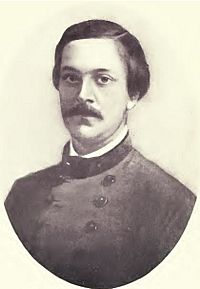J. Thompson Brown facts for kids
Quick facts for kids
John Thompson Brown
|
|
|---|---|

J. Thompson Brown
|
|
| Born | February 6, 1835 Virginia |
| Died | May 6, 1864 (aged 29) Spotsylvania County, Virginia |
| Allegiance | |
| Service/ |
|
| Years of service | 1861–64 |
| Rank | |
| Battles/wars | American Civil War |
John Thompson Brown (born February 6, 1835 – died May 6, 1864) was a Confederate Army colonel during the American Civil War. He was an expert with artillery, which means he was skilled with cannons.
Brown was part of the first time Confederate and Union forces exchanged cannon fire in Virginia. This happened at the Battle of Gloucester Point on May 7, 1861. His artillery company, the Richmond Howitzers, fired at the Union gunboat USS Yankee. No one was hurt in this small fight. Some people say Brown fired the very first shot of the Civil War in Virginia. During the war, he rose from a low rank to become a colonel in charge of many cannons in the Army of Northern Virginia. He was killed in battle on May 6, 1864, at the Battle of the Wilderness.
Contents
Early Life and Family
John Thompson Brown was born in Virginia on February 6, 1835. His parents were John Thompson Brown and Mary (Willcox) Brown. He married Mary Southall on April 14, 1858. Before the Civil War, Brown was a successful lawyer in Richmond, Virginia. He had two brothers, Henry Peronneau Brown and John Willcox Brown, who also served in the war.
Joining the Civil War
The Richmond Howitzers were a group of volunteer soldiers formed in 1859. They were created after John Brown's raid on Harpers Ferry. John Thompson Brown, even though he wasn't a trained soldier, became a second lieutenant in the Howitzers.
On May 7, 1861, Brown's company fired its first shots from Gloucester Point, Virginia. This was against the Union Navy gunboat USS Yankee. This small fight was the first military action reported in Virginia during the war. Brown was elected captain of his company just two days later.
Early Battles and Promotions
About a month later, on June 10, 1861, Brown's artillery unit fought at the Battle of Big Bethel in Virginia. He quickly moved up in rank, becoming a major in September 1861 and a lieutenant colonel in the spring of 1862.
Brown led the First Virginia Artillery during the Seven Days Battles. He was promoted to the rank of colonel on June 2, 1862. He continued to lead his artillery unit in important battles like the Battle of Antietam and the Battle of Fredericksburg.
Artillery Commander
In 1863, at the Battle of Chancellorsville, Brown's artillery unit played a key role. He helped protect Confederate soldiers during a major movement by Stonewall Jackson's corps. After another officer was wounded, Brown took charge of all the artillery for Jackson's corps.
After Jackson's death, Colonel Brown became the commander of the artillery for the II Corps of the Army of Northern Virginia. His cannons were used in battles like the Second Battle of Winchester and the Battle of Gettysburg. At Gettysburg, his guns helped cover the army's retreat back to the Potomac River.
Final Campaign and Death
Before the Overland Campaign began, Brown was given command of one of the two artillery divisions in his corps. On May 6, 1864, while looking for a good spot for his cannons, Colonel J. Thompson Brown was killed by a sharpshooter. Other generals praised him for his strong character and great skill.

